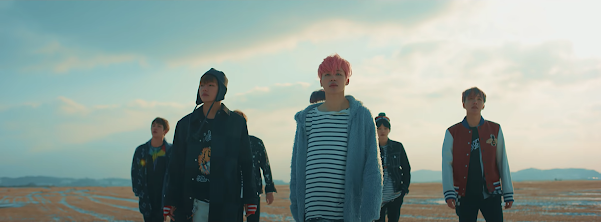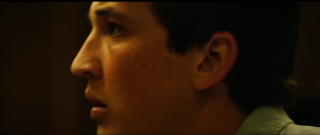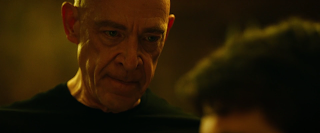Ophelia A level media Blog
Friday, 3 March 2023
Wednesday, 25 January 2023
Wednesday, 16 November 2022
Extra music video analysis (Y13 media study period)
Music Video Analysis.
BTS (방탄소년단) '봄날 (Spring Day)' Official MV
BTS have several factors that have contributed to their exponentially rising popularity, but the most outstanding factor is the deeper message that they deliver through their music. Released in 2017, “Spring Day” is BTS’s longest-charting track. It goes beyond the typical love song and its music video not only includes but transcends past aesthetics. A close visual analysis of the “Spring Day” music video leads one to find a profound message that is up to interpretation. It contains visual elements, appropriately accompanying lyrics, and literary references to Christian Boltanski’s No Man’s Land and Ursula K. Le Guin’s “The Ones Who Walk Away From Omelas,” all of which lead to comfort in dealing with the loss of a loved one and the overarching concept of “you never walk alone.”
“Spring Day” is regarding the Sewol Ferry Tragedy since the release of its music video, largely because of the number of scenes in the music video that seem to allude to the tragedy. The first allusion can be detected in the opening scene of the music video where Taehyung lays his head down on the train tracks at an abandoned train station. This is possibly a depiction of the survivor’s guilt (feelings of guilt for being the one that survived a life-threatening event while the others did not) that many involved in the Sewol Ferry Tragedy suffered shortly after the accident, with a number of them even attempting or committing suicide.
Another sequence in the video that makes an allusion to the tragedy is the one where BTS member Jimin is on a seashore, alone.
These same shoes can then be spotted in several scenes of the music video, with their final appearance being in the ending scene of the video where they are hanging on a tree branch. This is also a symbolism for death. In addition to these scenes, there are other allusions to the tragedy that typically go unnoticed.
In the scene at the laundromat, a “Don’t Forget” sticker can be seen on the dryers, while in another scene, a carousel with several yellow ribbons tied onto it is shown. Both these details may seem minor, but are in fact highly significant as they symbolise solidarity with the Sewol Ferry Tragedy’s victims and their families.
In addition, we cannot discuss this particular music video without mentioning “Omelas.” Quite a few times a motel named “Omelas” appears in the video, which is a reference to “The Ones Who Walk Away From Omelas,” a short story written by Ursula K. Le Guin. This short philosophical fiction is a coming-of-age story told in the utopian city of Omelas where everything is unbelievably perfect. The narrator soon reveals that the happiness of the town depends on the suffering of a single child, that is, the child must constantly suffer in order for the town to maintain its perfection and prosperity. The existence of the child and why the child is left in perpetual misery is revealed to the children of Omelas when they come of age, leaving many feeling shocked and sickened. The city will turn into a dystopia if they help the child in any way, so they are left with two choices: accept the reality for the greater good or walk away from Omelas (Le Guin, 1975)(Wikipedia.org).
In the “Spring Day” music video, the Omelas motel is first shown when BTS member RM walks up to it while the “No Vacancy” sign is lit up and BTS members J-Hope and Suga are standing outside it talking.
Throughout “Spring Day,” there are several juxtaposing scenes that either cut or zoom out to highlight the theme of “You are not alone,” which is in line with the title of the BTS album “Spring Day” belongs to —You Never Walk Alone. The initial scenes make the viewers think that a BTS member is alone in a particular setting, but later in the video the full shots are revealed and show all seven BTS members together, thereby conveying their message that no individual is truly alone.
BTS and the music video director’s intent here, as seen in their album description, is to provide a “message of warm consolation and hope for the suffering youth of this generation” (BTS Website 2017). “Spring Day,” both the music video and the song, gradually shifts from a sorrowful present to a hopeful future, and the music video is skilfully shot and edited to achieve this ambience. The moving lyrics in the bridge of the song is, “The morning will come again. No darkness, no season can last forever”
These lyrics and the stills illustrated represent the transition from winter to spring. The thawing of the snowy field, the bare tree sprouting new leaves and flowers, and the flower petals flowing through the wind, all signify the coming of a spring day and a brighter future. Spring represents new life and new beginnings and in the music video BTS is approaching it together, tying back to the overall theme of You Never Walk Alone.
Tuesday, 1 November 2022
Scene Analysis
Baby Driver scene analysis:
https://www.youtube.com/watch?v=7ARFyrM6gVs
Part 1: The setup.
(I decided to do this in two parts, the first one to show what Edgar Wright sets up in the first half of the scene, and the second one to talk about the car chase (a personal favorite))
This first scene sets up the movie without any exposition or dialogue. The film will use what the audience hears and sees first to set up the opening. Edgar Wright does this in the very beginning, before we even see anything we hear a high pitched tone that transforms into a musical note giving the audience an idea of who our main character is and who we should be sympathetic towards. The viewers won't find out until later into the film that Baby listens to music because of his tinnitus, but the seed is planted firmly at the beginning. In Baby Driver the sound dominates video, which is different to usual films. So it makes sense that we hear the music before any images in this scene Therefore hinting to Baby's tinnitus and giving audio a crucial role in the film. The three opening shots easily give us context for the setup of the main character and the world it is based in.
We see cars and a bank, a sign telling us what city we're in.
Then we see Baby's red Subaru fill the screen, defining it's importance for the rest of the scene.
The second thing we see is Baby's Ipod. Signifying that the music in Baby Driver's soundtrack is also canon in the world of the film itself.
We hear what Baby hears, the music isn't just there for the audience. By making this the second shot of the movie, Wright is also emphasizing the important role that music will play in this film.
Finally we see our main character close up aka Baby:
This is where another important decision happens. Even though the more interesting thing, the movement of the action is moving into the bank, Wright uses a wide shot and perspective to separate Baby from the crew. And the audience stay in the car with Baby.
This not only gets us comfortable with the fact that the rest of the story will play out from Baby’s perspective, it helps us separate him from the criminal world.
Wright quickly reminds us however, that this separation is just an illusion. The coincidence of a passing police car awakens Baby from his reverie. And Baby’s view of what’s happening in the bank serve as a harsh reminder for us and for Baby of what he’s involved with.
The second part of the scene consists of a car chase. This whole scene has so many short cuts that are about 2 seconds long each. This speed of cutting works here because the scene functions almost more as a musical montage of a car chase, than as a real time depiction of a car chase. There are many apparent jumps, some smaller and some larger, but this all kind of works because of the strong role the music plays. Every sound effect is on beat with the music. We spend just as much time inside the car than out.
Edgar Wright prioritises showing the feeling of the scene over clarity of physical action. Like in this shot where we don’t see the car swerve over into another lane, but we can almost feel it swerve because we can see the movements and reactions of everyone in the vehicle.
Of like this moments a few seconds later where we never actually see the car make a u turn, but a shot of Baby pulling the handbrake, and the passengers bodies shifting in their seats as the car turns is enough to clue us into what happened.
The scene is built around one thing. Baby and his car. The police even take a huge backseat. To me what sets this scene apart. It’s singular focus, Baby and his Car. This mirrors the singular focus of the film, Baby and his Driving. Often in chase scene like this, the lead car just seems to be following a predetermined path. But in this scene it’s clear that they are able to get away because of Baby’s clever driving. Also I find it incredible that there is nobody talking, theres only the character's gasps and the music but you still know exactly whats happening.
Friday, 30 September 2022
Lights, Camera, Action
Friday 30th September
LO: to understand and practice using the principles of film making.
shot type
shot sizes, m tone meaning
establishing shot crucial
master shot confirms location and characters in scene, their relationships
used for longer scenes
wide shot (ws) visually represent their relationship in their environment
long shot to show people in full, make statements in all their glory
medium full/ medium long shot top of the subjects head to the waist present subject as confident and confrontational
medium short, above the waist below the waist, above their chest, just above the head utilise a true middle ground approach
MCU medium close up, reduce distraction get intimate with a character head to chest
close up (cu) highlight a change in emotion in a dramatic scene dramatically effective
Extreme close up shot, focus on a features, emphasis,
insert shot, used to highlight an important object
framing
singles, feature s on e character, primary focus used to convey a characters isolation
two shot, both faces must be visible, visual relationship between two characters
three shot, four shot...
over the shoulder hybrid of single and two shot, focus on one character at a time, perspective on both sides
pov , pov shot with pov audio
insert shot detail, way information is framed is more important
camera angle
low angle, below a subject eye line, make subject more powerful
high angle makes a subject look less powerful, diminish a character, appear weak. environments, cities, landscapes
overhead camera directly above the subject, capture details
dutch angle off kilter image sense of unease, terror or bewilderment, magnify tension,
eye level,
shoulder level, slightly low angles but less dramatic emphasise a hight difference, can also advance an affectionate glance
hip level,
knee level shot, at knee height, doubling a slow angles
ground level, to track a characters movements,
camera movement
"Not quite my tempo" Whiplash scene
in this scene Fletcher is getting Andrew to play the drums instead of the core drummer, the music keeps cutting which shows how aggravated Fletcher is becoming, because it's not the tempo he was looking for. This also shows that Fletcher is in control. Not just in the room, but in the film as well. Fletcher raises his hand to stop the band, however this motion causes a cut from the camera as well.
These are subtle film making ways to build power with Fletcher. Stop after stop diffuses his reaction but not his power. His soft demeanour is coming in contrast to the power he is wielding. We see eight of those stopping motions, and it makes you tired until you get Fletcher bopping his head and turning around only to throw a chair at Andrew.
The tone has shifted entirely. Before Fletcher threw the chair, we were getting typical shots, single shots primarily of both characters. and the way you frame these shots, is so that way the characters heads are roughly the same size. After Fletcher throws the chair, we get a side profile shot of disbelief focused on Andrew, but Fletcher still shown in a medium shot
.These characters are not on equal basis now. The angle and size difference of these shots now show the superiority.
Until the action finally tilts forward now we see them both in the same shot (a two shot). When Andrew is told to count in tempo and gets slapped in the face by Fletcher, there's a cut on every hit. Since the camera is jumping to the other side of the characters, it looks like a back and fourth motion (to me its almost like a seesaw).
When asked rushing or dragging, the shot changes, they're now at a hybrid single shot at a low angle to make Fletcher look more powerful.
Then we come back to that earlier profile with the next shot. In conclusion the scene keeps building tension to give you the same kind of feeling that Andrew is feeling throughout that whole scene.
Not quite my tempo scene
Friday, 9 September 2022
Skills development
9/09/2022
L/O: research, plan and produce a product in response to a brief.
Genre: Indie Rock
Album title: I Can Talk
Band name: The Revival Division
Songs for the back of the album:
1. Symphony Sickness
2. Runaway
3. Centre of Attention
4. Where u At?
5. Orangeade
6. I Don't Know How I Feel About This
7. Sweet Chaos
8. Syndrome
9. Rule The World
10. Mixtape
The album's theme and storyline is about running away. It starts with Symphony Sickness, talking about someone that has had enough of the same four walls and the same small town and how it's taking a toll on the character's mental health. Therefore, in track two "Runaway", -as stated in it's name- The character decides to run away from home in hopes of finding something new and exciting. In this small town the characters disappearance becomes the main focus of the town "Centre of Attention" explains that. "Orangeade" is merely just a filler song, purely just mentioning how everything is going well. The character of this album starts having regrets when things start not going the way they planned "I Don't Know How I Feel About This" briefly shows the doubt that the character is having. In "Sweet Chaos" is showing both worlds: The small town in panic and also how the character is feeling about this whole situation. " Syndrome" is about how the character is feeling homesick and lost, after a while they will find the courage to let everyone know that they're alright and have been finding their way in the world. At this point the character is is feeling on top of the world. Everything has been going their way and they get to pursue their dream of creating music when finally the final song on the album "Mixtape" is the final release.
Website link:
https://RevivalDivision.com/home
front cover:
back cover:
Wednesday, 7 September 2022
Media Intro
I lived in France for roughly 15 years meaning I am fluent in French! I love all kinds of music but there are a few artists that piqued my interests recently, such as: Lovejoy, Mitski and many more. I love gaming, I mainly play The Sims 4 and Minecraft. My first concert was a BTS concert in 2019, right before COVID-19 hit.
-
Baby Driver scene analysis: https://www.youtube.com/watch?v=7ARFyrM6gVs Par t 1: The setup. (I decided to do this in two parts, the first...
-
Music Video Analysis. BTS (방탄소년단) '봄날 (Spring Day)' Official MV BTS have several factors that have contributed to their exponentiall...
-
Friday 30th September LO: to understand and practice using the principles of film making. shot type shot sizes, m tone meaning establishin...



















































